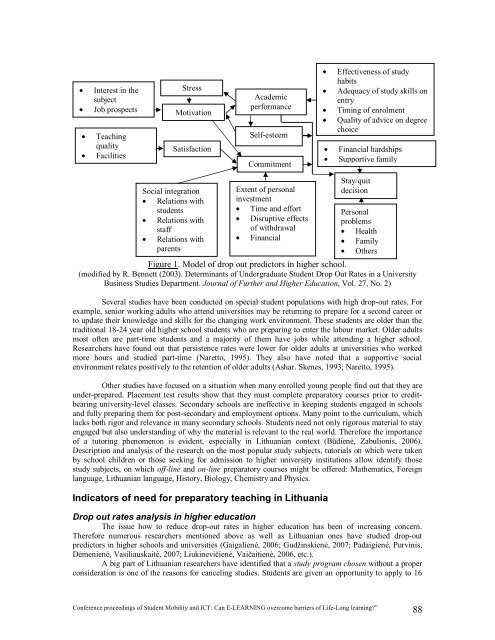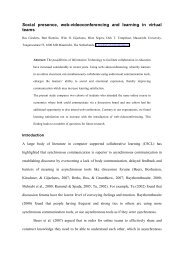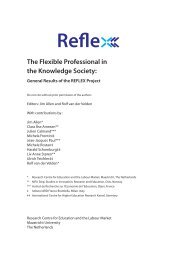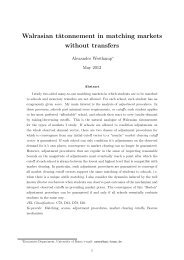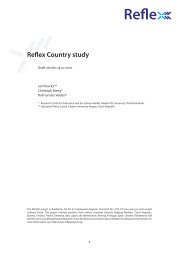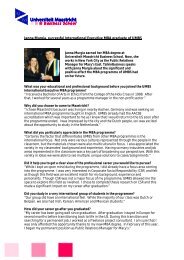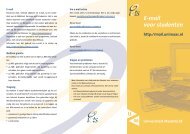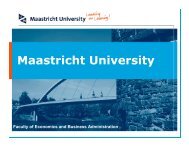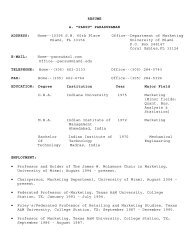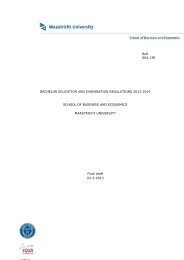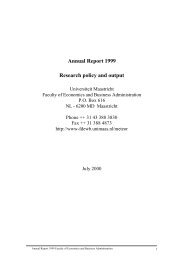proceedings of Student Mobility and ICT: Can E-LEARNING
proceedings of Student Mobility and ICT: Can E-LEARNING
proceedings of Student Mobility and ICT: Can E-LEARNING
You also want an ePaper? Increase the reach of your titles
YUMPU automatically turns print PDFs into web optimized ePapers that Google loves.
• Interest in the<br />
subject<br />
• Job prospects<br />
• Teaching<br />
quality<br />
• Facilities<br />
Stress<br />
Motivation<br />
Satisfaction<br />
Social integration<br />
• Relations with<br />
students<br />
• Relations with<br />
staff<br />
• Relations with<br />
parents<br />
Academic<br />
performance<br />
Self-esteem<br />
Commitment<br />
Extent <strong>of</strong> personal<br />
investment<br />
• Time <strong>and</strong> effort<br />
• Disruptive effects<br />
<strong>of</strong> withdrawal<br />
• Financial<br />
Figure 1. Model <strong>of</strong> drop out predictors in higher school.<br />
(modified by R. Bennett (2003). Determinants <strong>of</strong> Undergraduate <strong>Student</strong> Drop Out Rates in a University<br />
Business Studies Department. Journal <strong>of</strong> Further <strong>and</strong> Higher Education, Vol. 27, No. 2)<br />
Several studies have been conducted on special student populations with high drop-out rates. For<br />
example, senior working adults who attend universities may be returning to prepare for a second career or<br />
to update their knowledge <strong>and</strong> skills for the changing work environment. These students are older than the<br />
traditional 18-24 year old higher school students who are preparing to enter the labour market. Older adults<br />
most <strong>of</strong>ten are part-time students <strong>and</strong> a majority <strong>of</strong> them have jobs while attending a higher school.<br />
Researchers have found out that persistence rates were lower for older adults at universities who worked<br />
more hours <strong>and</strong> studied part-time (Naretto, 1995). They also have noted that a supportive social<br />
environment relates positively to the retention <strong>of</strong> older adults (Ashar. Skenes, 1993; Naretto, 1995).<br />
Other studies have focused on a situation when many enrolled young people find out that they are<br />
under-prepared. Placement test results show that they must complete preparatory courses prior to creditbearing<br />
university-level classes. Secondary schools are ineffective in keeping students engaged in schools<br />
<strong>and</strong> fully preparing them for post-secondary <strong>and</strong> employment options. Many point to the curriculum, which<br />
lacks both rigor <strong>and</strong> relevance in many secondary schools. <strong>Student</strong>s need not only rigorous material to stay<br />
engaged but also underst<strong>and</strong>ing <strong>of</strong> why the material is relevant to the real world. Therefore the importance<br />
<strong>of</strong> a tutoring phenomenon is evident, especially in Lithuanian context (Bdien, Zabulionis, 2006).<br />
Description <strong>and</strong> analysis <strong>of</strong> the research on the most popular study subjects, tutorials on which were taken<br />
by school children or those seeking for admission to higher university institutions allow identify those<br />
study subjects, on which <strong>of</strong>f-line <strong>and</strong> on-line preparatory courses might be <strong>of</strong>fered: Mathematics, Foreign<br />
language, Lithuanian language, History, Biology, Chemistry <strong>and</strong> Physics.<br />
Indicators <strong>of</strong> need for preparatory teaching in Lithuania<br />
• Effectiveness <strong>of</strong> study<br />
habits<br />
• Adequacy <strong>of</strong> study skills on<br />
entry<br />
• Timing <strong>of</strong> enrolment<br />
• Quality <strong>of</strong> advice on degree<br />
choice<br />
• Financial hardships<br />
• Supportive family<br />
Stay/quit<br />
decision<br />
Personal<br />
problems<br />
• Health<br />
• Family<br />
• Others<br />
Drop out rates analysis in higher education<br />
The issue how to reduce drop-out rates in higher education has been <strong>of</strong> increasing concern.<br />
Therefore numerous researchers mentioned above as well as Lithuanian ones have studied drop-out<br />
predictors in higher schools <strong>and</strong> universities (Gaigalien, 2006; Gudžinskien, 2007; Padaigien, Purvinis,<br />
menien, Vasiliauskait, 2007; Liukineviien, Vaiaitien, 2006, etc.).<br />
A big part <strong>of</strong> Lithuanian researchers have identified that a study program chosen without a proper<br />
consideration is one <strong>of</strong> the reasons for canceling studies. <strong>Student</strong>s are given an opportunity to apply to 16<br />
Conference <strong>proceedings</strong> <strong>of</strong> <strong>Student</strong> <strong>Mobility</strong> <strong>and</strong> <strong>ICT</strong>: <strong>Can</strong> E-<strong>LEARNING</strong> overcome barriers <strong>of</strong> Life-Long learning?” 88


